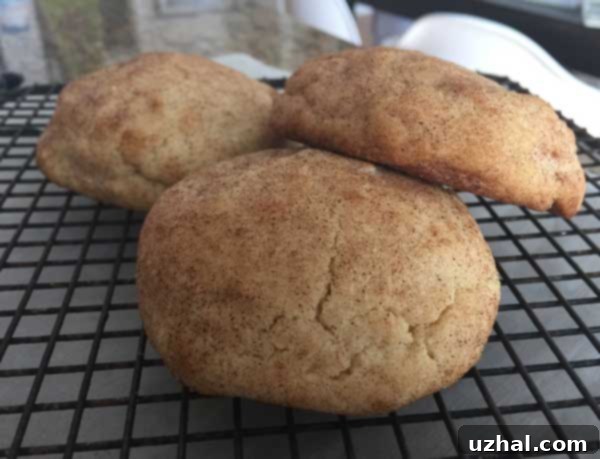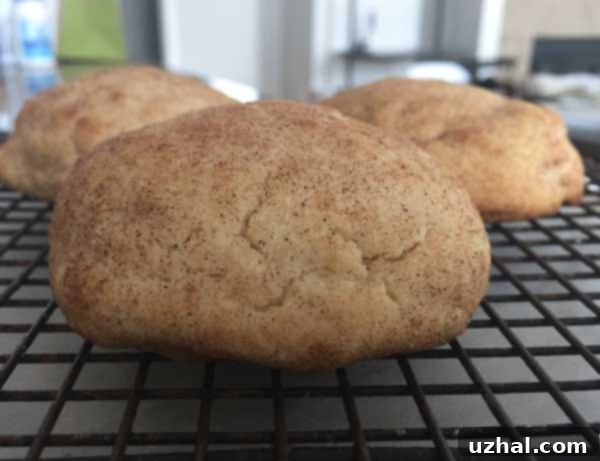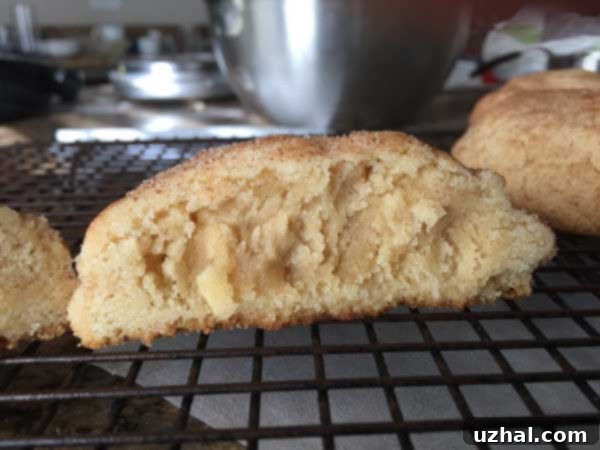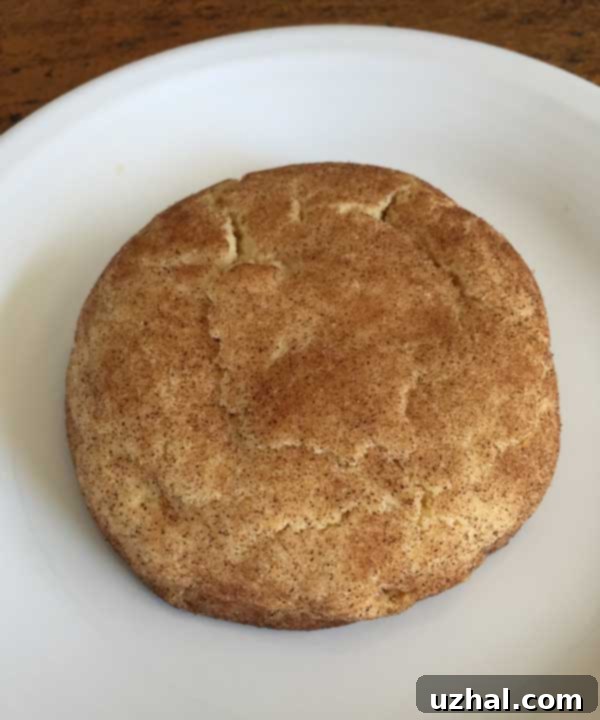Roasted Flour Snickerdoodles: Unlock Deeper Flavor and Irresistible Texture in Your Favorite Cookie
Have you ever wondered how to add a layer of complex flavor to your baked goods, pushing them beyond the ordinary? Chefs often employ a secret technique: roasting flour. While commonly used to deepen the flavor of savory sauces and gravies, this method can transform your sweet treats, too. Spreading flour on a sheet pan and baking it not only imparts a subtle, nutty aroma but also fundamentally alters its structure, leading to a truly unique and memorable result in recipes like cookies and breads. Our adventure into the world of Roasted Flour Snickerdoodles began as an experiment to see just how this time-honored technique would elevate an all-time classic cookie, and the results were nothing short of spectacular.

Beyond the enhanced flavor profile that some detect from the baked flour itself, the primary and most striking benefit of roasting flour for cookies lies in its profound impact on texture. By removing some of the moisture and altering the protein structure of the flour, you achieve a cookie with distinct textural properties that simply can’t be replicated with raw flour. Imagine a snickerdoodle that is at once wonderfully crumbly, yet astonishingly soft and moist on the inside, offering a satisfying bite that is both delicate and substantial. This unique characteristic is what truly sets Roasted Flour Snickerdoodles apart, making them a must-try for any baking enthusiast looking to elevate their cookie game.

The Irresistible Texture of Roasted Flour Snickerdoodles
The transformation in texture is perhaps the most compelling reason to embrace roasted flour in your snickerdoodles. Unlike their traditional counterparts, these Roasted Flour Snickerdoodles exhibit minimal spread during baking, maintaining a lovely, plump shape. The interior is a marvel of contrasts: wonderfully crumbly, yet simultaneously soft and incredibly moist. This delightful chewiness, combined with a delicate crispness around the edges, creates an utterly addictive eating experience. You might notice a subtle yellow hue in the cookies, which can often be attributed to using high-quality organic butter, as was the case in my kitchen when Whole Foods had a fantastic sale. Once you experience the difference this technique makes, you’ll likely find yourself, like me, utterly hooked. My only concern now is what I’ll do when that organic butter goes back to its regular price!
Enhancing Flavor and Richness with Roasted Flour
Beyond texture, the act of gently drying and baking the flour in the oven contributes significantly to the overall flavor of these snickerdoodles. It seems to amplify the inherent buttery notes in the cookie, especially when paired with good quality butter. The roasting process adds a subtle, almost toasted dimension that complements the sweet cinnamon-sugar coating beautifully, creating a more sophisticated and deeply satisfying flavor profile. These aren’t just snickerdoodles; they are an experience in elevated baking, where every ingredient plays a crucial role in the final symphony of taste and texture.

Crafting Giant, Shareable Cookies
For this particular recipe, I intentionally kept the batch size relatively small, yielding fewer, but significantly larger, cookies. Each cookie weighs approximately 4 ounces – truly giant delights! I strongly believe that this substantial size is key to achieving the desired textural effect. Smaller cookies might not develop the same interplay of crumbly softness and moist chewiness. Therefore, I highly recommend embracing the “giant cookie” philosophy for these Roasted Flour Snickerdoodles. They make exceptional gifts for loved ones, impressive contributions to bake sales, or simply a magnificent treat to enjoy yourself over several sittings. Imagine the delight on someone’s face receiving one of these substantial, gourmet cookies!

I genuinely hope you fall in love with this unique snickerdoodle recipe as much as I have. The subtle art of roasting flour truly unlocks new possibilities in your baking. And for those who enjoy a bit of chocolate with their roasted flour goodness, keep an eye out! Tomorrow, I’ll be sharing the much-anticipated Roasted Flour Chocolate Chip cookie version, a recipe that promises another delightful twist on a classic.
A Few More Baking Notes & Expert Tips for Perfect Cookies
To ensure your Roasted Flour Snickerdoodles turn out absolutely perfect, I’ve made some crucial updates and refined the process. This updated recipe now calls for a blend of flours: 1 cup of un-roasted bread flour (weighing approximately 140 grams) combined with 40 grams of roasted all-purpose flour (weighed *after* roasting). This specific combination yields the ideal balance of structure and the unique texture we’re aiming for.
The Importance of Proper Creaming and Chilling
The creaming process is also vital. Cold butter and sugar should be creamed together in a stand mixer for a full 4 minutes. This extended creaming incorporates sufficient air, which contributes to the cookies’ light yet chewy interior. You’ll notice the mixture becoming light and fluffy, signaling it’s ready for the next steps. After preparing the dough, shaping it into balls should be fairly easy. However, don’t skip the chilling step! A minimum of 2 hours in the refrigerator is essential for the dough to firm up properly. This crucial step prevents excessive spreading in the oven, ensuring your cookies bake up nice and fat, with that desirable thick texture.
Achieving Your Desired Doneness
When it comes to baking, oven temperatures can vary, so consider these guidelines flexible. For my oven, baking at 375 degrees Fahrenheit for approximately 25 minutes consistently yielded perfectly baked cookies. However, if you prefer a slightly doughier center, a baking time of 20 minutes might be just right for you. Always keep an eye on your cookies, as a minute or two can make a significant difference. Look for golden edges and a set but still slightly soft center.

Why Roast Flour? The Science Behind the Deliciousness
The magic of roasted flour isn’t just a culinary myth; it’s rooted in science. When flour is heated, several things happen. Firstly, moisture evaporates, concentrating the starches and proteins. Secondly, the Maillard reaction occurs – the same chemical reaction responsible for the browning and complex flavor development in roasted meats, toasted bread, and caramel. This reaction creates hundreds of new flavor compounds, adding depth and nuttiness that raw flour simply doesn’t possess. For cookies, this translates to a more robust flavor profile and a different interaction with moisture during baking, contributing to the unique crumbly-yet-soft texture. It’s a simple step that yields a profound impact, transforming your baking from good to extraordinary.
- Brown Sugar Snickerdoodles
- Snickerdoodle Cookie Bark
- Brickle Snickerdoodles
- Crunchy Roasted Pecan Chocolate Chip Cookies
- Date Paste Vegan Snickerdoodles
Roasted Flour Snickerdoodles Recipe

Roasted Flour Snickerdoodles
Cookie Madness
Pin Recipe
Ingredients
- 1 cup bread flour 140 grams
- ⅓ cup roasted all-purpose flour 40 grams (weighed after roasting)
- 1 teaspoon baking powder
- ½ teaspoon salt
- 1 stick unsalted butter 114 grams, softened
- ¾ cup granulated sugar 150 grams
- 1 large egg beaten
- ½ tablespoon vanilla extract
Rolling Mixture
- 2 tablespoons granulated sugar
- 1 teaspoon ground cinnamon
Instructions
-
Roasted Flour Preparation:
-
Preheat your oven to 350 degrees F (175 degrees C). Line a rimmed baking sheet with aluminum foil for easy cleanup.
-
Spread about a cup or two of all-purpose flour thinly and evenly across the foil-lined baking sheet (you won’t use all of it for this specific recipe, but it’s good to roast extra for future baking). Bake for 15 minutes. The flour should not turn deeply brown, but it will develop a noticeably fragrant, nutty aroma and may form some lumps. Once cool enough to handle, transfer the flour to a large bowl and use a whisk or your hands to mash out any lumps. For a super fine texture, you can sift it and then mash out any remaining stubborn lumps. Allow the roasted flour to cool completely to room temperature before incorporating it into the cookie dough. Once cool, carefully weigh out 40 grams (this is approximately ⅓ cup, but using a kitchen scale will ensure the most accurate measurement for consistent results).
-
Cookie Dough Preparation:
-
In the bowl of a stand mixer fitted with the paddle attachment, beat the softened unsalted butter on medium speed until it’s light and creamy. Add the granulated sugar and continue to beat for a full 4 minutes, making sure to scrape down the sides of the bowl frequently with a spatula to ensure everything is well combined. This extended creaming is crucial for incorporating air and achieving the desired cookie texture. Next, add the beaten egg and vanilla extract, and beat for an additional minute until thoroughly incorporated.
-
In a separate medium bowl, whisk together the 1 cup (140g) of un-roasted bread flour, the 40 grams of cooled roasted all-purpose flour, baking powder, and salt. Gradually add this dry mixture to the wet ingredients in the stand mixer, mixing on low speed until just combined to form a soft dough. Be careful not to overmix. Divide the dough into 4 equal portions and gently shape each portion into a large ball. Place these dough balls on a plate or small baking sheet and chill them in the refrigerator for at least 2 hours, or until they are firm. This chilling step is vital for preventing the cookies from spreading too much during baking.
-
Preheat your oven to 375 degrees F (190 degrees C). Line a large baking sheet with parchment paper.
-
Prepare the rolling mixture: In a small bowl or a zipper-lock bag, combine the 2 tablespoons of sugar and 1 teaspoon of cinnamon. Once the dough is firm, take one chilled dough ball at a time, place it in the bag with the cinnamon-sugar mixture, and shake gently to coat it completely and evenly.
-
Arrange the coated cookie dough balls a few inches apart on the prepared baking sheet. Given their large size, you might only fit two per standard baking sheet to allow for proper air circulation.
-
Bake the cookies at 375 degrees F (190 degrees C) for 20-25 minutes. The baking time will depend on your oven and desired doneness. For a doughier cookie, aim for 20 minutes. For a firmer, more set cookie, bake closer to 25 minutes. The edges should be golden, and the center should appear set but still slightly soft.
-
Once baked, allow the cookies to cool on the baking sheet for a few minutes before carefully transferring them to a wire rack to finish cooling completely. This helps them firm up and prevents them from breaking.
-
For best storage, especially if making a larger batch, wrap cooled cookies individually in plastic wrap and store them in an airtight container in the freezer. They will maintain their freshness and texture beautifully for several weeks, ready for a quick thaw and a delicious treat anytime!
Conclusion: A New Era for Your Snickerdoodles
Roasting flour is more than just a technique; it’s an invitation to explore new dimensions of flavor and texture in your baking. Our Roasted Flour Snickerdoodles recipe is a testament to this, transforming a beloved classic into an extraordinary treat with a crumbly yet moist interior and an undeniably enhanced buttery flavor. By taking the simple step of baking your flour, you unlock a depth that will surprise and delight everyone who takes a bite. Whether you’re baking for a special occasion, a thoughtful gift, or simply to treat yourself to an unparalleled cookie experience, these giant snickerdoodles are sure to become a new favorite in your repertoire. Don’t hesitate to try this innovative approach to baking – your taste buds will thank you!
